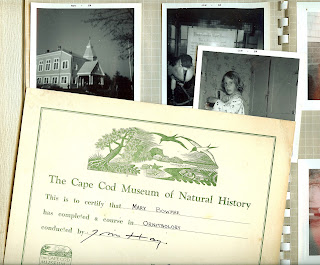There are several kinds of whelks common to Cape Cod but on the south side Hyannis, Centerville and Osterville beaches I frequent, the knobbed whelk is the most common.
Here is the shell of one washed up on the beach. I can’t help but collect these lovely shells and they decorate many of my window sills.
Whelks are gastropods and are really just big snails. In some parts of the country and other parts of the world you may hear them referred to as conchs thought true conchs are a bit different. If you walk the beach in the fall or winter you may find these long twisty egg cases. These are the egg cases of the knobbed whelk. The cases of the channeled whelk look similar but have got sharper edges to the individual cases.
Often the cases that wash up still have some shells in them. I cut this one open to show the baby whelks that did not survive. Like all mollusks the young grow with their shells. They do not shed them like crustaceans such as crabs.
Here you can see the relative sizes of an adult whelk, the egg case and the baby whelks.
And since it is still a bit chilly to sit in the damp sand and draw I brought them home to sketch in my trusty moleskine.

